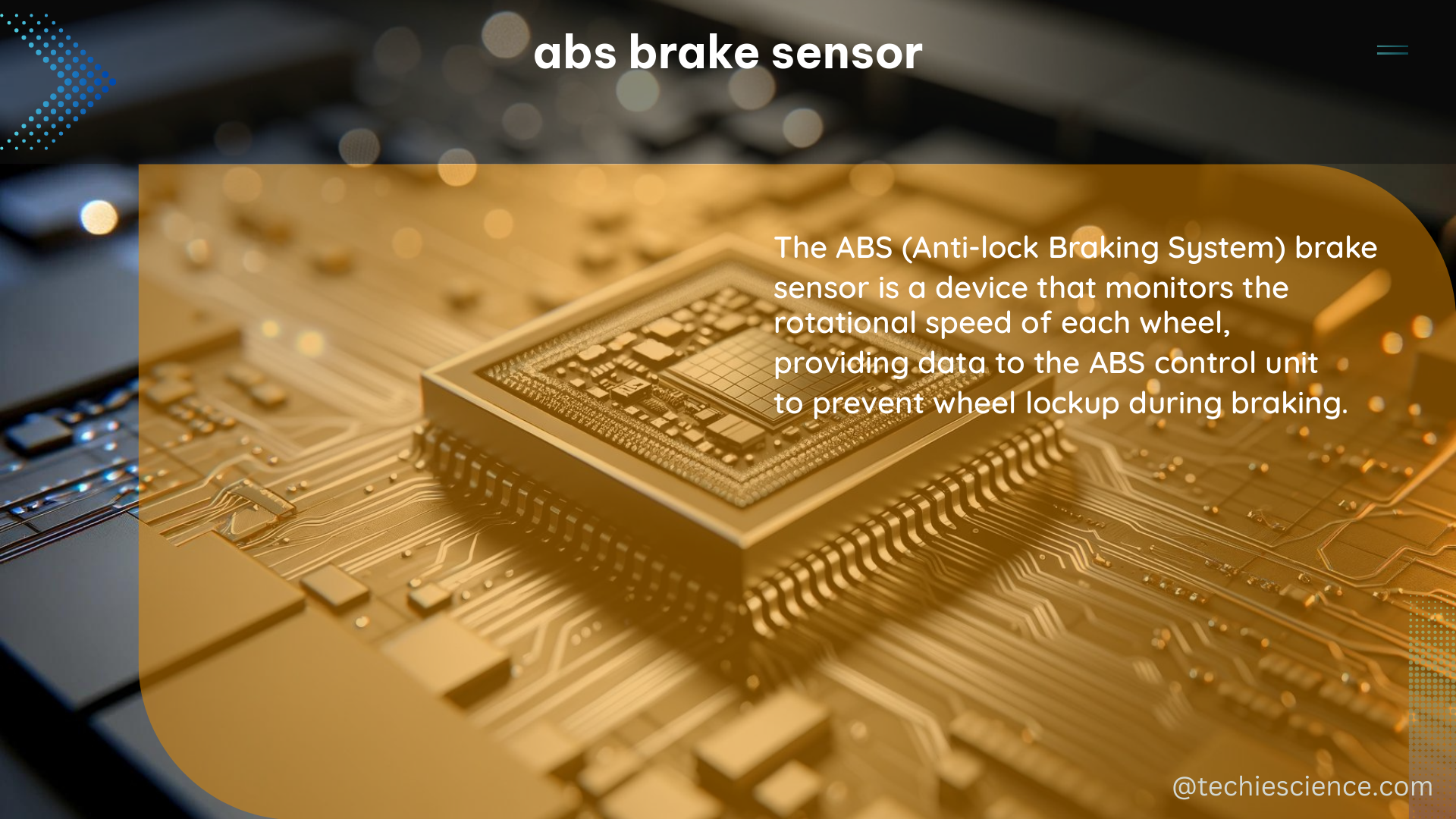The ABS (Anti-lock Braking System) brake sensor, also known as the wheel speed sensor, is a critical component in modern vehicles, responsible for ensuring safe and controlled braking. This sensor measures the rotational speed of the wheels and transmits this information to the ABS control unit, which then uses it to prevent the wheels from locking up during hard braking, maintaining vehicle stability and steering control.
Understanding the Principle of Operation
The ABS brake sensor operates based on the principle of electromagnetic induction. It consists of a toothed wheel, or impulse ring, attached to the brake disc or drive shaft. As the wheel rotates, the toothed wheel passes over a stationary sensor, causing a change in the magnetic field. This change induces a measurable alternating voltage in the sensor’s winding, with the frequency and amplitude of the signal being proportional to the wheel speed.
Types of ABS Brake Sensors

There are two main types of ABS brake sensors: active and passive.
Active Sensors
Active sensors require a separate power supply from the control unit. They use a magneto-resistive element to detect the changing magnetic field produced by a multipole ring integrated into the wheel bearing.
Passive Sensors
Passive sensors, also known as inductive-passive sensors, do not require a separate power supply. They generate a signal based on the changing magnetic field induced by the rotation of the toothed wheel.
Measuring Wheel Speed
The frequency and amplitude of the signal generated by the ABS brake sensor are crucial for accurate wheel speed measurement. For example, in a vehicle traveling at 60 mph, the wheel speed sensor may generate a signal with a frequency of approximately 1200 Hz. The amplitude of the signal may vary depending on the sensor’s design and the vehicle’s speed.
| Vehicle Speed | Sensor Frequency |
|---|---|
| 30 mph | 600 Hz |
| 45 mph | 900 Hz |
| 60 mph | 1200 Hz |
| 75 mph | 1500 Hz |
The table above shows the approximate relationship between vehicle speed and the frequency of the signal generated by the ABS brake sensor.
Diagnosing ABS System Faults
When it comes to diagnosing faults in the ABS system, the frequency and amplitude of the signal generated by the wheel speed sensor can provide valuable diagnostic information. For instance:
- A decrease in signal amplitude may indicate a dirty or damaged sensor.
- An increase in signal frequency may indicate a faulty wheel speed sensor or a damaged toothed wheel.
By monitoring these signal characteristics, technicians can quickly identify and address issues within the ABS system, ensuring optimal braking performance and safety.
Technical Specifications
The ABS brake sensor must meet stringent technical specifications to ensure reliable operation. Some key specifications include:
- Sensor Type: Active or Passive
- Sensor Output: Alternating Voltage
- Frequency Range: 0.5 Hz to 10 kHz
- Voltage Range: 0.2 V to 12 V
- Operating Temperature: -40°C to 150°C
- Vibration Resistance: Up to 50 g
- Shock Resistance: Up to 100 g
These specifications ensure that the ABS brake sensor can withstand the harsh operating conditions of a vehicle and provide accurate wheel speed data to the ABS control unit.
Maintenance and Replacement
Regular inspection and maintenance of the ABS brake sensor are crucial to ensure its proper functioning. Common issues that may arise include:
- Sensor Contamination: Dirt, debris, or corrosion can interfere with the sensor’s operation, leading to inaccurate wheel speed readings.
- Sensor Damage: Physical damage to the sensor or the toothed wheel can cause the sensor to malfunction.
- Wiring Issues: Damaged or loose wiring can disrupt the signal transmission between the sensor and the ABS control unit.
If any issues are detected, it is essential to replace the ABS brake sensor with a genuine, manufacturer-approved part to maintain the integrity of the ABS system.
Conclusion
The ABS brake sensor is a vital component in modern vehicles, responsible for providing the ABS control unit with accurate wheel speed data. By understanding the principles of operation, sensor types, and technical specifications, technicians can effectively diagnose and address issues within the ABS system, ensuring safe and reliable braking performance for drivers.
References:
- BRAKE DISCS AND WHEEL SPEED SENSORS IN ABS SYSTEMS, HELLA PAGID, PDF.
- Check and change ABS and wheel speed sensors – HELLA, HELLA.
- ABS wheel speed sensor – measuring vehicle speed – Arduino Forum, Arduino Forum.

The lambdageeks.com Core SME Team is a group of experienced subject matter experts from diverse scientific and technical fields including Physics, Chemistry, Technology,Electronics & Electrical Engineering, Automotive, Mechanical Engineering. Our team collaborates to create high-quality, well-researched articles on a wide range of science and technology topics for the lambdageeks.com website.
All Our Senior SME are having more than 7 Years of experience in the respective fields . They are either Working Industry Professionals or assocaited With different Universities. Refer Our Authors Page to get to know About our Core SMEs.